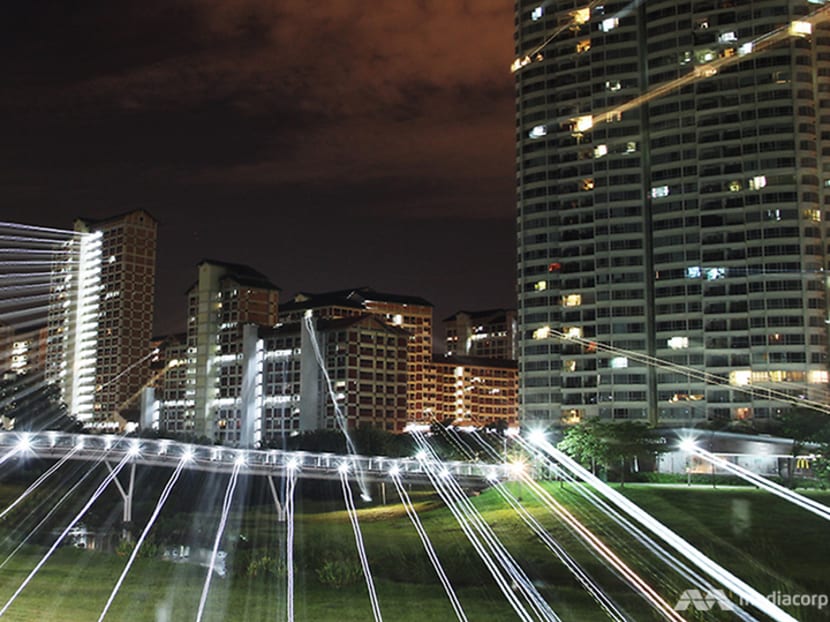Lights out for some electricity retailers in Singapore: Why and what it means for consumers

Bishan Park at night. (Photo: CNA/Marcus Mark Ramos)
SINGAPORE: Citing unfavourable market conditions, three electricity retailers have abruptly thrown in the towel in quick succession over the past week, sending shockwaves across Singapore’s electricity market.
The latest to call it quits is Best Electricity, which said on Tuesday (Oct 19) that the volatile energy market left it “with no other choice”.
This came on the back of similar announcements last week by iSwitch, the largest independent retailer in the country’s Open Electricity Market, followed by smaller player Ohm Energy two days later.
Earlier this week, Union Power said it will cease about 850 retail accounts as part of a business reorganisation. The independent retailer stressed, however, that it is not exiting the market.
Industry experts reckoned it would not be a surprise if more retailers decide to head for the exit given the “perfect storm” in the global and domestic energy markets.
“The exit of electricity retailers and market consolidation has impacted consumers, employees and the remaining retailers. This is the first time we are experiencing this since the Open Electricity Market was rolled out to households in 2018,” said business lecturer Tan Tsiat Siong from the Singapore University of Social Sciences.
“This will have implications on future regulation and monitoring of the Open Electricity Market.”
We break down what is happening and what this means for the future of Singapore’s Open Electricity Market.
A RECAP ON THE OPEN ELECTRICITY MARKET
This was a move to fully liberalise the electricity retail market in Singapore, which first started as a pilot project in 2018 before being rolled out nationwide by mid-2019.
Simply put, it allowed all households to pick and choose electricity price plans offered by more than 10 retailers, instead of getting power solely from SP Group at the quarterly-reviewed regulated tariff.
There are two types of retailers in the Open Electricity Market.
One is the “gentailers”, such as Keppel Electric and Geneco, that are generating and selling electricity.
Then there are the independent retailers which do not generate their own electricity but buy electricity from the wholesale market where prices change every 30 minutes depending on demand and supply.
Hence, conditions in the wholesale market play a key role in determining the business strategies of the latter group of retailers. The ability to hedge against fluctuations is another important factor.

WHAT’S BEHIND THE VOLATILE MARKET CONDITIONS?
Singapore’s wholesale electricity market has seen “higher price volatility for sustained periods” in the past fortnight, said the Energy Market Authority (EMA) in a statement over the weekend.
This is caused by several factors – a significant rise in global spot liquefied natural gas (LNG) prices due to higher demand and lower production; higher-than-usual electricity demand domestically; and a reduction in the supply of piped natural gas from Indonesia.
In another statement on Tuesday, the EMA warned of rising supply disruption risks in Indonesia. The global energy crunch – brought about by a cocktail of factors such as severe weather events and recovery in economic activities from the pandemic – has also made it much more expensive for power generation companies to secure additional spot LNG to make up for the drop in piped natural gas supplies.
Daily trading reports by the Energy Market Company – the operator of Singapore’s wholesale electricity market – provide a sense of this market volatility.
From Oct 3 to Oct 16, the daily average Uniform Singapore Energy Price (USEP) traded between S$121.10 to S$1,821.60 per megawatt hour (MWh). Intra-day figures showed an even wilder ride, with the USEP on Oct 14, for instance, peaking at S$3811.16/MWh and going as low as S$267.82/MWh.
The USEP is the price paid by electricity retailers for their purchases in the wholesale market.
Even before this month, the USEP has shot through the roof on several occasions. One such spike occurred between Jul 26 and 29 when prices averaged at S$418/MWh, nearly three times more than the level seen in the preceding week.
This sparked an investigation by the EMA, which said an “unplanned curtailment” of piped natural gas supply from Indonesia had occurred in conjunction with a planned curtailment for maintenance during the four-day period. An independent panel, which surveils and investigates the conduct of market players, found that no rules were breached.
Nonetheless, such price volatility in the wholesale market has hurt some electricity retailers, especially those who “have under-hedged their positions”. These players “may find it challenging to sustain their operations and may choose to exit the market”, the EMA said over the weekend.
The power-industry regulator added that it is working closely with retailers facing challenges, such as facilitating their efforts to hedge against future price volatility.
In its latest statement on Tuesday, it said it is monitoring the wholesale electricity market “closely and will intervene if necessary”.
WHAT’S HEDGING AND WHY ARE RETAILERS STILL EXPOSED?
EMA requires all electricity retailers in the Open Electricity Market to hedge at least 50 per cent of their contracted load against wholesale electricity prices.
Hedging is a process of locking in prices for the longer term to guard against increases.
This is generally a costly endeavour and smaller players may lack the financial muscle to do more, said Mr Tan.
While companies may have differing capabilities, the ability to hedge also depends on the state of the futures market which of late has given retailers “no exit” either, said Dr David Broadstock, a senior research fellow and lead energy economist at the National University of Singapore’s Energy Studies Institute.
He noted that Singapore’s electricity futures have been trading higher than the historical average and the forward curve suggests that such elevated prices are set to stay for the next two years.
“There are different contracts looking forward to January and February for example, and when I plot them out, I get what's called the forward curve which shows me the forward-looking prices,” explained Dr Broadstock.
“These contracts will continue trading so they are not guaranteed but now, there is nothing there which looks nice … If we take iSwitch as an example, were they just bad at hedging? That doesn’t matter if the market doesn't present the opportunities.
“And this is probably why they decided to exit the market because they are facing a situation where the wholesale market is volatile and prices are expensive, and where they would try to hedge that uncertainty with a futures contract is now giving them an uncomfortable position,” he continued.
“So the question is, where’s the viable business opportunity? (This) strongly suggests iSwitch will be making massive losses if they stay in business. With that, will other retailers be able to miraculously endure these situations?”
ARE THERE JUST TOO MANY ELECTRICITY RETAILERS?
The ongoing turmoil has also left some wondering if there are far too many retailers for a small market like Singapore.
Prior to the exits, there were 12 approved retailers in the Open Electricity Market.
“If there are too many retailers in Singapore, they simply cannot reap any economies of scale,” said Mr Tan.
That said, experts told CNA that it is difficult to pinpoint an optimum number of players. Artificially setting one also runs counter to the purpose of liberalising the electricity retail market.
“Market liberalisation means you open it up to whoever wants to participate and can make a case for it. If they do, they get a licence and whether they survive depends on their own business practices,” said Professor Subodh Mhaisalkar, executive director of the Energy Research Institute at Nanyang Technological University.
"So I think there's no way in a liberalised market that the EMA can dictate that it wants seven or 10 players. It has to be left to the open market."
WHAT MORE CAN AUTHORITIES DO?
Dr Broadstock said instead of focusing on the number of retailers, the current crisis has thrown up other more pertinent questions.
For instance, what can be done to foster business resilience in a competitive market.
“The issue here is that competition causes the profit margins to become thin. This is the natural organisation of markets but when profit margins are thin, the ability to build up financial reserves declines,” he explained.
“The absence of financial reserves then prohibits resilience to sustain negative market conditions.”
Mr Tan suggested three ways to create a more sustainable business environment in the electricity retail market.
First, authorities can look to regulate and monitor the fixed-price plans that are being offered, such as restricting them to shorter lock-in periods, given that these longer-term plans are “inherently exposed to larger price risks”.
Second, authorities can assess if the hedging requirement should be raised, given that the existing rule of 50 per cent does not seem to offer retailers adequate protection in the event of price spikes.
“The world has seen larger fluctuations. A higher hedge ratio might be needed but that would also mean higher costs to all,” said the business lecturer.
Third, the exit of retailers can be better managed.
“Retailers could forfeit their previously withheld deposit if they were to cease operation without sufficient notice. The funds could then be used to compensate affected consumers,” said Mr Tan, adding that retailers need to be held accountable.
In its statements, the EMA has repeatedly stressed that safeguards for consumers are in place. For example, retailers exiting the market are not allowed to charge an early termination fee and will have to refund any remaining security deposits after offsetting outstanding charges.
The authority also gave the assurance that there will be no disruption to the electricity supply of affected customers.
WHAT DOES THIS MEAN FOR CONSUMERS?
In the near term, households that are renewing their electricity plans may see an increase in prices given the higher costs of electricity production.
Overall, consumers should also be expecting bigger electricity bills given how 95 per cent of Singapore’s electricity is generated from imported natural gas.
Earlier this month, Trade and Industry Minister Gan Kim Yong nudged households to use electricity “prudently” as costs are set to rise following the doubling of fuel prices.
Still, Prof Mhaisalkar said one should not be too quick to write off the Open Electricity Market, as the initiative did achieve cost savings for those who switched to buying electricity from a retailer over the past few years.
The market has also seen some unique bundled services and innovative offerings in the area of green energy.
While consumers are likely to have fewer options in the near term as global developments spur the pace of market consolidation, this is “not necessarily something to be alarmed”, he added.
“I don't think there’s a concern that what has happened recently could affect the broader Open Electricity Market. Clearly a couple of other players are going to exit but I think everyone expected consolidation to happen at some point and this is more likely to happen when conditions are bad,” said Prof Mhaisalkar, noting that similar consolidations have also happened elsewhere like the UK.
Agreeing, Mr Tan also said “limited choices might not be a bad thing”, citing his personal experience of having to sieve through “too many choices” before deciding on an electricity retailer.
“From a consumer point of view, I think less than 10 choices would be sufficient, and more is not always better."
The business lecturer went on to say that consumers here did not have any options before the Open Electricity Market was launched in 2018.
“Facing higher renewal plans is unavoidable, and also fair and reflective of market conditions. What we should be comparing is the prices offered by the current Open Electricity Market and the counterfactual – if there was only one retailer. I would say the liberalisation of the retail electricity market has brought prices down,” he said.
Moving forward, electricity retailers that remain standing may be spurred by this crisis to do more to differentiate themselves beyond price and stay ahead of the competition, said Prof Mhaisalkar.
For instance, they can go beyond electricity and provide solutions for energy management and others.
“Just building on the recent statement by the minister on energy conservation, it will be interesting to see if any retailers can step up to the challenge with more proactive offerings,” he said.












